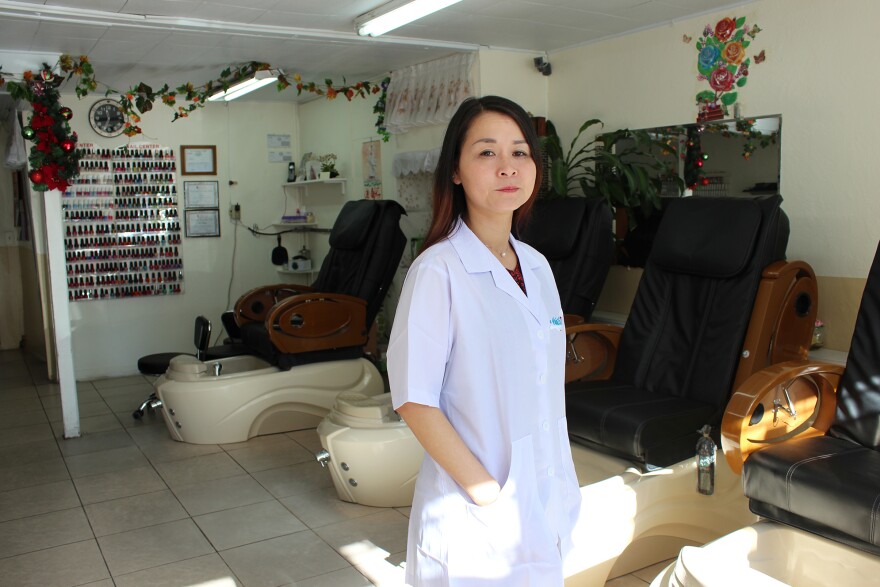What stands out upon entering Mai Dang's nail salon, located on a busy street in Berkeley, Calif., is what's missing — the stinging smell of polish, remover and other nail products. That wasn't always the case. For a decade, Dang suffered from the effects of the chemicals she used at work every day.
"When you do nails, workers get itchy skin and watery eyes," says Dang, 40. She also used to have frequent headaches, and one of her workers developed asthma. So when she heard about an opportunity to improve the safety at her salon, she signed up.
"I work every day. I need the air to be pure, to be better for me. I have to take care of my health this way," she says, speaking in Vietnamese through an interpreter.
Asian Health Services, a community clinic in Oakland, started The California Healthy Nail Salon Collaborative after the clinic identified a pattern of illness among nail salon workers.
"Practically every worker was experiencing some kind of health issue. And we realized that this was an epidemic," says Julia Liou, planning and development director at the clinic and the co-founder of the collaborative.
Nail salons are big business in the United States — approximately $8.5 billion in revenue in 2015. Some of the chemicals used in salons are known to cause skin disorders and respiratory problems, and possibly even cancer, miscarriages and birth defects. Formaldehyde and toluene are just two of the risky ingredients in the nail polishes, solvents, glues and hardeners in constant use in salons; the Environmental Protection Agency lists at least 20 such worrisome chemicals.
But, so far, there's been little government regulation to protect workers. Liou is trying to get salon owners to make changes voluntarily to improve worker safety.
"We don't want to create a fear where it's like, 'Oh nail salons are so scary that people can't go to them,' " explains Liou. "But we want to create a space where both the owner and the customer can feel comfortable, and actually create a model where the return on investment ends up being worker health."
Salons that participate in the collaborative must make significant changes to their business, including buying less toxic nail polishes, thinners and removers. All workers are required to wear specific types of gloves and masks when using certain products. Owners are also required to purchase a portable mechanical ventilation unit.
"It sucks in the air when I do artificial nails so the workers don't have to breathe in the toxic chemicals anymore," explains Dang, as she turns on the machine with a remote control. More than 80 percent of salon workers in California are Vietnamese American, and more than half are of reproductive age, according to the collaborative.

Alameda County certified Dang's salon, Fashion Nails, as a healthy salon in 2013, based on her changes. In return, Dang got a certificate that she hangs in her window to let customers know she is part of the collaborative. Fashion Nails is also listed as a healthier nail salon on a county website.
The process, however, was not cheap. Dang says the products she now uses, while safer, cost about 30 percent more. Overall, she estimates that she spent about $3,000 on the upgrades. To pay for it, she raised her prices by $2 per service.
One of Dang's customers, Genell Johnson, says she's more than willing to pay extra for the service.
"You get what you pay for," Johnson says. "That's what they always say, and it's very true."
A survey of customers by the collaborative found that 90 percent were willing to pay at least a dollar more for services they knew were healthier. Johnson says she's a regular at Fashion Nails but had no idea it was a healthy salon.
"Now I'm going to spread the word," says Johnson. "This will be the perfect place, knowing they're so health conscious."
For Dang, the investment in a healthier salon seems to be paying off. Visits to her salon have increased, and her business has become more profitable, she says.
But getting businesses to make changes voluntarily is a slow process. Out of more than 8,000 nail salons in California, only 120 have joined the collaborative so far.
"I think the ultimate root of the issue is that the chemicals are still in the products," says collaborative co-founder Liou. "If we want to look at really how do we improve worker health, we also need the manufacturers to consider how they can they make safer products as well."
Still, the Healthy Nail Salon Collaborative is making progress. The EPA recently gave the collaborative a grant to help them offer microloans to salons wanting to upgrade.
In September, California passed legislation to help expand the program across the state, by training cities and counties on how to certify healthy nail salons in their regions.
Kaiser Health News is a national health policy news service. It is an editorially independent program of the Henry J. Kaiser Family Foundation. You can follow Jenny Gold on Twitter: @JennyAGold.
Copyright 2023 Kaiser Health News. To see more, visit Kaiser Health News.

